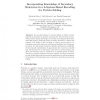148 search results - page 3 / 30 » The evolutionary capacity of protein structures |
BMCBI
2004
13 years 7 months ago
2004
Background: The wealth of information on protein structure has led to a variety of statistical analyses of the role played by individual amino acid types in the protein fold. In p...
AE
2005
Springer
14 years 1 months ago
2005
Springer
An encoding scheme for protein folding on lattice models, inspired by parametric L-systems, was proposed. The encoding incorporates problem domain knowledge in the form of predesig...
NAR
1998
13 years 7 months ago
1998
The FSSP database and its new supplement, the Dali Domain Dictionary, present a continuously updated classification of all known 3D protein structures. The classification is deriv...
CEC
2009
IEEE
14 years 2 months ago
2009
IEEE
— Automatic protein structure predictors use the notion of energy to guide the search towards good candidate structures. The energy functions used by the state-of-the-art predict...
BMCBI
2010
13 years 7 months ago
2010
Background: Proteins show a great variety of 3D conformations, which can be used to infer their evolutionary relationship and to classify them into more general groups; therefore ...

